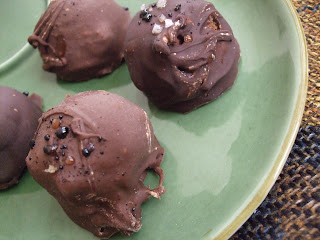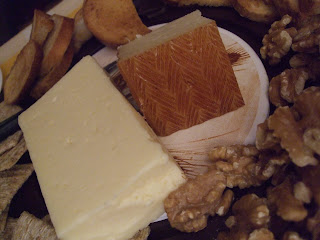I have to admit, this recipe is supposed to be called "cake balls," but while being a bit giggle-inducing that name is also a little misleading: people expect to bite into the chocolate coating and find, well, a ball of cake, when in reality it is a ball of FROSTING and cake, which makes it moist, light, and buttery. You almost wouldn't guess there is cake inside, since it mostly tastes like a confection you would buy at a candy store.
In addition to being frightfully yummy, these goodies are also a fabulous back up plan when cakes don't turn out properly. If you make a cake, and it is too dry, crumbly, flat, dense, etc., you can just break it up into crumbs in a bowl, mix in some frosting, form balls, dip them in chocolate, and suddenly the failed cake is a delicious and presentable treat. Not a bad back up to have!
I ended up making these mocha cake bonbons because I made cupcakes that fell apart a bit when picked up; I had played around a little too much with the recipe, and the result tasted good but had the wrong texture. I even decided to make the cake balls after I had decorated the individual cupcakes - just threw them in a bowl and broke them up, evening the frosting throughout.
You've got three flavors to choose in a cake bonbon: the cake, the frosting, and the dipping chocolate. And hey, you can even top them with a decoration or flavor accentuations like I did here with instant coffee flakes and coarse sea salt.

Cake Bonbons
1 cake (the equivalent of one cake mix, which makes a 9"x13" pan, two 8" or 9" pans, or 24 cupcakes)
1 recipe buttercream or cream cheese frosting (see below for recipes)
2 12-oz packages of chocolate chips (I used one of milk and one of dark - why not?)
After the cake is baked and cooled, break it up into pieces in a large mixing bowl. Add the frosting, and mix in evenly throughout the cake crumbs. You want the texture to be relatively smooth, so you can form 1" diameter balls of the mixture that will stick together. If you've started with an already frosted cake (wedding cake leftovers, for example), just dump the frosted cake into a bowl and stir. Refrigerate or freeze the formed balls on parchment-lined baking sheets until they are firm, so that they won't fall apart when you dip them in the melted chocolate.
When the formed balls are ready, melt one bag of chocolate chips (I like to do this in a 2-cup Pyrex glass measuring cup so that there's some depth when you dip the balls in it). If you're doing the melting in the microwave, just heat it in 30 second intervals and stir well in between so that you do not burn the chocolate. Many prefer to melt chocolate in a double boiler, but I find the microwave simpler and sufficient.
Dip each ball in the chocolate, using a fork in each hand to pull the coated ball out of the chocolate while letting the excess drip off. Set on parchment to dry, and top with any decorations or flavor accentuations. Repeat with second bag of chocolate chips (I do one bag at a time, since the chocolate cools down as you're dipping the balls).
Buttercream Icing
1 C butter
1 t vanilla
1 lb. powdered sugar (approx. 4 C)
2 T milk or cream (reduce for stiffer icing)
1 C butter
1 t vanilla
1 lb. powdered sugar (approx. 4 C)
2 T milk or cream (reduce for stiffer icing)
Cream the butter and vanilla with an electric mixer or stand mixer until well combined.
Add the powdered sugar gradually until smooth.
Add milk 1 T at a time; use less for stiffer icing.
Cream Cheese Frosting
1 cube butter, softened at room temperature
8 oz. cream cheese (do not use low-fat cream cheese)
1 tsp vanilla
1 lb. powdered sugar, sifted (about 4 C)
Cream together the butter and cream cheese with a hand mixer or stand mixer.
Add vanilla and, gradually, the powdered sugar.
Whip until light.
1 cube butter, softened at room temperature
8 oz. cream cheese (do not use low-fat cream cheese)
1 tsp vanilla
1 lb. powdered sugar, sifted (about 4 C)
Cream together the butter and cream cheese with a hand mixer or stand mixer.
Add vanilla and, gradually, the powdered sugar.
Whip until light.

























































